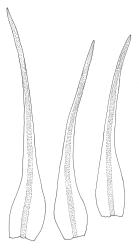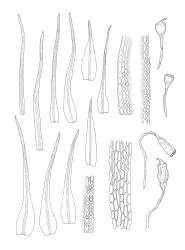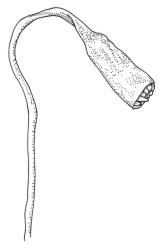Plants dark green to brown-green, erect, rather dull. Stems erect, simple (or branched if perigonia are present), c. 0.5 mm, usually 2(–3) arising from a common base. Leaves flexuose-erect when dry, not altered or slightly secund when moist, (0.4–)1.0–1.5(–2.7) mm (including perichaetial leaves), subulate from a narrowly ovate to ± obovate base, entire, gradually or ± abruptly narrowed to the subula, the lower portion ± sheathing the stem; mid laminal cells often bistratose, mostly in 1–3 rows beside the costa, rounded-quadrate to rounded and short-oblong, 6–12 × 5–6 µm, smooth, moderately thick-walled; lower laminal cells larger (to c. 24 × 12 µm), mostly rectangular; basal and alar cells not differentiated. Costa weak below, obscure, filling the upper leaf.
Apparently autoicous. Perichaetial leaves not or slightly differentiated from vegetative leaves, with expanded base reaching ½ the leaf length. Perigonia terminal and on short lateral branches of male shoots that appear to arise from the base of perichaetial shoots, the bracts short and broadly acute. Setae 2.5–3.2 mm, strongly flexuose and twisted to the right when dry, strongly cygneous when moist; capsules exserted, ellipsoid when mature and moist, ± smooth, pendent due to curvature of the seta, symmetric, the neck short and poorly defined, 0.5–0.8 mm; columella short and immersed; exothecial cells irregularly rounded-oblong, ± evenly thin-walled; cells at rim rounded, subquadrate and more pigmented; annulus not differentiated; stomata as per genus; operculum conic-rostrate, oblique, not systylious, apparently not falling with the calyptra. Peristome of 16, short, reddish, lanceolate teeth, smooth except for thickened, transverse walls on outer surface, smooth on inner surface, inserted near the mouth, mostly extending c. 75–90 µm beyond the rim, ± erect, often fragile. Spores 8–12 µm, smooth or very faintly papillose, green.
This species could only be confused with S. cardotii, from which it is readily differentiated by the characters enumerated in the species key.
SI: Canterbury (Broken River basin including Castle Hill and Cave Stream, Mt Alford).
Endemic.
Among the most rarely collected moss species in N.Z., S. diminuta occurs in sheltered limestone crevices. The most recent collection from the Castle Hill area was collected at "Castle Rock" by J.K. Bartlett on 26 Aug. 1980 (CHR 266206), at an elevation of c. 820 m. Although Vitt & Bartlett (1983) recorded it from nearby Cave Stream, the collection they cited (CHR 266211) is predominantly S. cardotii and I have been unable to find any convincing S. diminuta in it. A collection of S. cardotii by G. Brownlie from the "Cave Stream area at 2200 ft." (CHR 428004) includes a few stems of S. diminuta, as well as Gymnostomum calcareum. An unlocalised collection by J.K. Bartlett from "Malvern Co." (AK 199137) contains several plants of Syntrichia muralis. The collection from Mt Alford (D. Glenny 89-559; WELT M026841) is relatively ample and contains only the single species. It was collected at 520 m from a "slightly overhanging face" of "limestone outcrops in pasture".
The dry setae in S. diminuta are flexuose and they become cygneous only with hydration.
Seligeria diminuta is given a current conservation ranking of nationally critical (the highest possible conservation ranking for a plant in N.Z.) by Glenny et al. 2011. Rock climbing and activities in Castle Hill and Cave Stream Scenic Reserves are likely to have an adverse impact on the long-term survival of this species. The location of populations in the general Castle Hill area, but off-limits to rock climbers, is desirable. Despite efforts to relocate this species there, no collections have been made in the Broken River basin more recently than 1980.
According to Vitt & Bartlett (1983), the small spore size, cygneous very long and thin setae, and long capsules with thin, delicate exothecial cells place this species in the subgenus Cyrtoseligeria. They suggest that it may prove to be conspecific with S. recurvata, which occurs in northern and central Europe and eastern and western North America.










